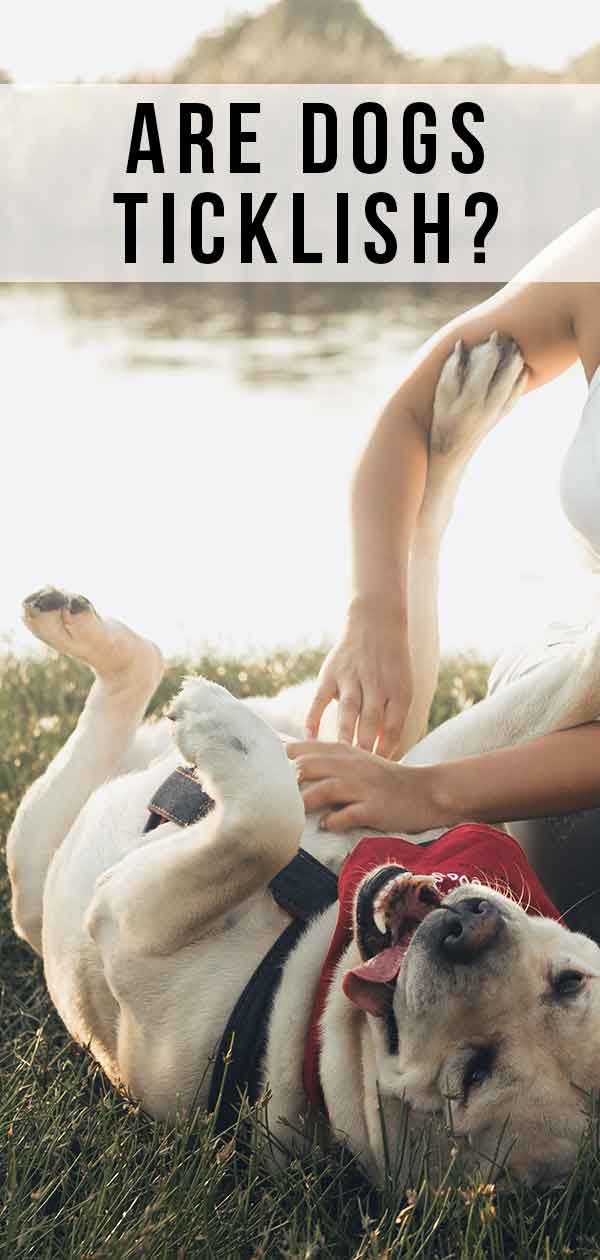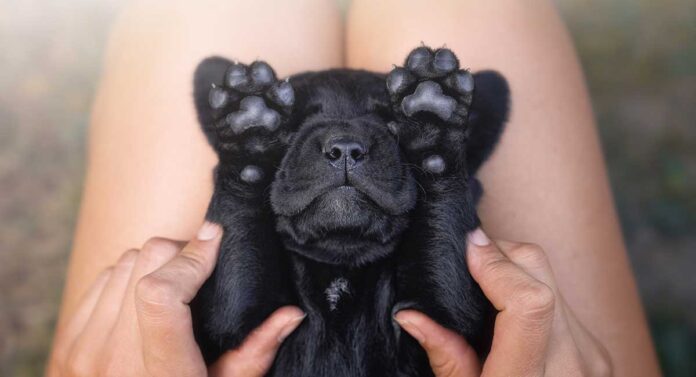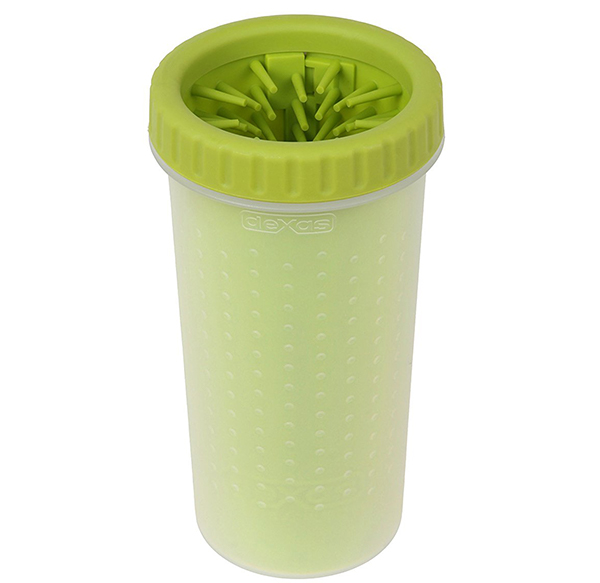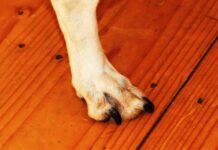Dogs are ticklish in a sense, although it isn’t the same as the reaction we get when someone tickles our skin. And just like us, some are more ticklish than others, and they have different tickle spots too. Technically your dog can be ticklish anywhere on their body, but your dogs neck, ears, tails and legs are typically thought to be more ticklish than other areas. And some reactions they give us when tickled aren’t actually as a result of them finding the sensation tickly at all!
Building a relationship and bonding with your dog is all about finding ways of playing and having fun together. And for us humans tickling is often an instinctive part of that. Consider your approach to meeting human babies – as soon as you’re sure their parents won’t mind, you tickle their cheeks to try and raise a giggle, and make a connection. But what about puppies and dogs? Are dogs ticklish? And if not, why aren’t dogs ticklish? Is there a dog tickle spot and does it give them canine giggles?
Can dogs be ticklish?
In 1897, psychologists G. Stanley Hall and Arthur Allin took to The American Journal of Psychology and coined not one, but two excellent new words to describe the sensation of being tickled. The first, knismesis, is the sensation of very light tickling which gives us goosebumps. For example, knismesis is feeling when an insect lands on your skin and makes your skin tickle and twitch. Importantly, knismesis doesn’t make you laugh.

The second kind of tickle sensation is gargalesis (I told you these words were good!). Gargalesis, or heavy tickling, is the feeling when your fingertips dig into your ribs or the soles of your feet and reduce you to hopeless laughter.
Can you tickle a dog?
Yes and no. Or perhaps yes and maybe. Knismesis is widespread in mammals, including dogs. Scientists have come to the conclusion that it is a natural reflex reaction.
In fact it’s easy to imagine how that tickly sensation would be an advantage. An insect landing on the skin, or parasites like fleas, can be detected and brushed or scratched away. But as far as we know, dogs don’t experience gargalesis in response to a vigorous tickle attempt from their human.
Gargalesis is a very strange reaction. Your laughter is generally in response to something that goes on in your head – a joke, a happy thought. Gargalesis is the only time when physical touch makes you laugh. Even stranger is that we often don’t actually enjoy the tickling that makes us laugh. And we can’t tickle ourselves. This makes scientists believe that it is also a natural reflex reaction.
We know many other primates, like gorillas and some monkeys, experience gargalesis. At Washington State University, Jaak Pankseep, Professor of Neuroscience, is building up evidence that rats experience something, if not the same, then similar to gargalesis. But so far, there’s been no evidence that tickling elicits a reflex response like gargalesis in your dog. However, some dog owners are adamant that their dogs laugh when they’re being tickled. Recent studies are providing a possible explanation for this.
Dog laughter
While you’re tickling your dog he might make a breathy panting sound that convinces you that they’re laughing. Patricia Simonet researched the sounds that dogs make and one distinct sound she found is a breathy, forced exhalation. She described this as a dog-laugh because dogs only make it when they’re playing and it differs from a normal panting sound.
A study she did showed that when recordings of the dog laughter were played to shelter dogs they became less stressed. The dogs also showed increased social behaviors towards other dogs – like play-bowing and lip licking. So you believe that your dog laughs when tickled? You’re probably seeing their play-laugh – especially if they’re giving you a huge dog smile as well.
So are dog’s ticklish?
We’ve ruled out the gargalesis response in dogs. But we’ve still got knismesis (light tickling), so let’s look some more at that. Can all dogs feel it, and do they like it?
Now here’s another funny thing about tickling (because let’s face it, everything about tickling is inherently a bit funny). We still don’t fully understand the neurological pathways that control knismesis. Including, for example, how it ends. Have you ever felt an insect crawl across your skin, and still felt the tickle from it for a few seconds after it’s gone? We have no idea why that time lag happens. Nor do we know why some of us are more susceptible to tickling than others, but it’s safe to assume that the same is true of dogs.
So your dog might not be ticklish at all. Others might twitch at the lightest touch. And still others will fall anywhere in between.
Where are dogs ticklish?
The sensation of being lightly tickled starts with nerve endings under the surface of the skin. Those nerve endings are all over your body, and your dog’s body. But we’re rarely ticklish all over. So how can we tell which areas on your dog are tickle-prone and which aren’t?
I have ticklish ribs. My sister has a really ticklish neck.The places where we’re ticklish are the idiosyncrasies that make us all different and unique. And the same is true of our dogs. Your dog might have ticklish ears, and your neighbor’s dog might have a ticklish tail. Every dog is different.

Is there a dog tickle spot?
You might already have identified a special dog tickle spot on your furry friend. You’ve noticed that your dog reacts in a very specific way if you scratch or tickle a certain spot on their body. It changes from dog to dog, but there’s often a spot on their back, sides, or tummy, which makes one of their legs twitch rhythmically when your scratch it. Their reaction makes it seem like finding your dog’s own dog tickle spot. So what’s going on?
You’ve found your dog’s scratch reflex, that’s what!
Ticklish dogs: the dog scratch reflex
The scratch reflex is when nerve endings under the skin pick up a signal and send it straight to the leg muscles via the spine, completely missing out the brain. It’s a bit like tickling, in that it’s an involuntary reaction. It’s the same type of response as the knee-jerk reflex in humans – when a sharp tap just below your knee bone makes you straighten your leg.
Dogs also sometimes make the same scratching movement when a flea or something else is irritating the dog tickle spot. Just like doctors use the knee-jerk reaction to test our reflexes, vets can use the scratch reflex to check for signs of spinal damage in dogs.
Whether your dog likes it or not is entirely down to the individual experience. In a minute we’ll look at how you can use his cues to tell whether he’s having a good time or not.
Are dogs’ feet ticklish?
Does your dog’s paw twitch and pull away if you pick it up? Perhaps wiping your dog’s paws after a muddy walk turns into a game of speed and quick reflexes to get the job done. When this happens your dog is probably feeling that knismesis sensation of tickling on their paws. They jerk their feet away in an involuntary reflex – just like when someone tickles our feet. But not all dogs’ feet are ticklish. Just like ours, some dogs’ feet are more ticklish than others.
If ticklish toes do make cleaning your dog’s feet difficult, a specialized paw cleaner like this one from Dexas(paid link) might help. It’s had good reviews from owners whose dogs resisted the sensation of having their feet cleaned.
So we’ve seen that most of the reactions we get from tickling a dog tickle spot are involuntary reflex reactions. You may be wondering now whether your dog likes being tickled and how to tickle your dog so that they enjoy it.
Do dogs like to be tickled?
Tickling, as we’ve seen, is a funny old business. It makes us giggle, but a lot of us would say we don’t enjoy the sensation. Especially as we get older. Charles Darwin believed there was an important social component to tickling.
When I play tickle games with my daughter I like the sensation of being tickled. But if someone I’ve never met tickled me without warning, I’d recoil, and probably feel quite upset by it. And it is likely to be the same for your dog. A playful tickle from someone they know as part of a game, or during grooming, might illicit a happy tail wag. But catching them unawares might be altogether more startling and unpleasant.
How to tickle a dog
The actual mechanics of how to tickle your dog are hardly rocket science. But just like humans, not all dogs feel the same about being tickled. And a tickle that starts out as fun can turn into a nuisance quite suddenly. Our dogs can’t use words to tell us when their patience has run out. So it’s up to us to look out for the behavioral cues which show they’re done being tickled.
Watch for signs of irritation or that they don’t really enjoy it, such as flinching or pulling away during the tickle or shaking off afterwards. And when your dog begins to lose interest, always call it a day and let them have their own space for a bit.
Where are dogs ticklish?
Dogs can technically be a little bit ticklish anywhere on their bodies. Tickling is made up of two components, light tickling called knismesis which makes us shiver, and heavy tickling called gargalesis which makes us laugh. Dogs feel light tickling, but don’t react to heavy tickling in the same way we do. How sensitive they are to tickling, and how they feel about it varies from dog to dog.
Finding a dog’s ticklish places is a fun and satisfying part of feeling like you know them better than anyone else in the world. You’ll soon learn what they like and how to tickle a dog so that they enjoy it. Just be sure to watch their behavior closely during tickle games and be respectful of signals that they’re not enjoying it or are losing interest.
Does your dog like to be tickled? Are they ticklish in a surprising place? Please tell us about your dog tickling experiences in the comments section below.
References
- Bering, J. 2012. Rats laugh, but not like humans. Scientific American.
- Harris, C.R. 2012. Tickling. Elsevier. Encyclopedia of Human Behavior.
- PetMD. Can dogs laugh.
- Smith, C.S. 2010. The little dog laughed. The function and form of dog play. International Association of Animal Behaviorists.
The Labrador Site Founder
Pippa Mattinson is the best selling author of The Happy Puppy Handbook, the Labrador Handbook, Choosing The Perfect Puppy, and Total Recall.
She is also the founder of the Gundog Trust and the Dogsnet Online Training Program
Pippa's online training courses were launched in 2019 and you can find the latest course dates on the Dogsnet website




















I play a little game with my dog called, “I’ll….get this one!” with light to medium pokes and pinches (usually going after the soft fleshy bits), and she loves it and gets very involved, almost as a form of light playfighting. It always garners many licks and I swear she does the same thing back to me, and she vocalizes, almost as if she is sayin, “Yeah? I’ll get this one then!”
Hours of endless fun. She’s a Bull Mastiff Terrier and not small but not a huge dog either. SHe is very emotional and very communicative and always smiling, until you get those sad eyes when she wants something. Her paws, tail, back (near the base of the tail), ears and ribs are tickle spots and she goes whacky when those places are exploited, usually with hilarious responses, as if she is reacting like a human who is being ‘forcibly tickled to death’. SHe’s awesome.
I have 2 dogs that definitely experience gargalesis, without a doubt, when we put them on their backs and tickle their bellies…they make very clear breathy laughing sounds. We have, also, had 2 dogs that got nothing out of it. I wouldn’t say that dogs are not capable of gargalesis, or that their only tickle response is the foot tap…I think a lot of people have had the same experience we have.
as an owner of 4 dogs tickling as I see it sometimes makes them uneasy. sometimes when they’re on play mode they probably like it but not entirely sure how they feel about it I guess the rub part there is really what they really like. One thing for sure though is they love to be scratch on the belly :). Dogs are all different so respect them if you see them walking away.
When I pet my dog lightly, or massage his ears or scratch him like all my other dogs have enjoyed, he starts a low, loud, “jerky” and threatening sounding growl. He doesn’t challenge me and he doesn’t move away until he can’t take it anymore. At that point he seems agitated. It does remind me of being tickled when I was a kid, and not really liking it, but laughing uncontrollably. He is a very vocal and sensitive dog otherwise, so I can only attribute his strange growling (and not like that gentle moaning sound) to a uncontrollable, forceful dog laughter related to tickling. He will stop when I put firm pressure on his tickle spots. Such a funny dog!